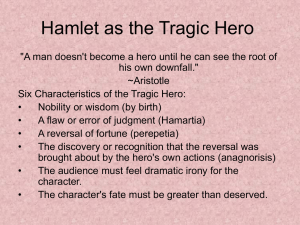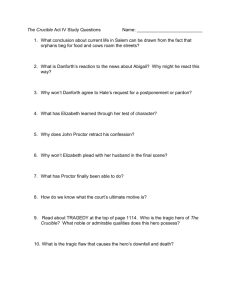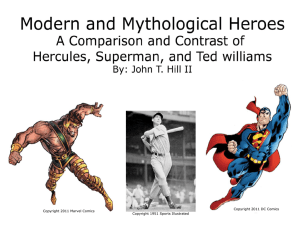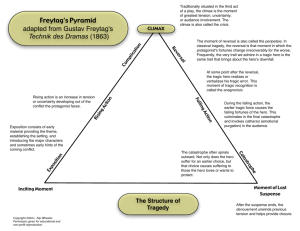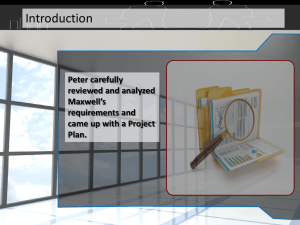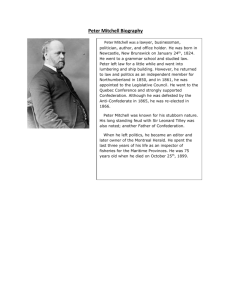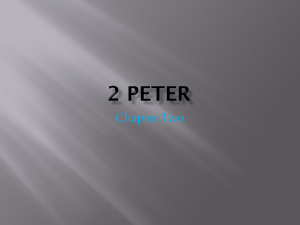File
advertisement
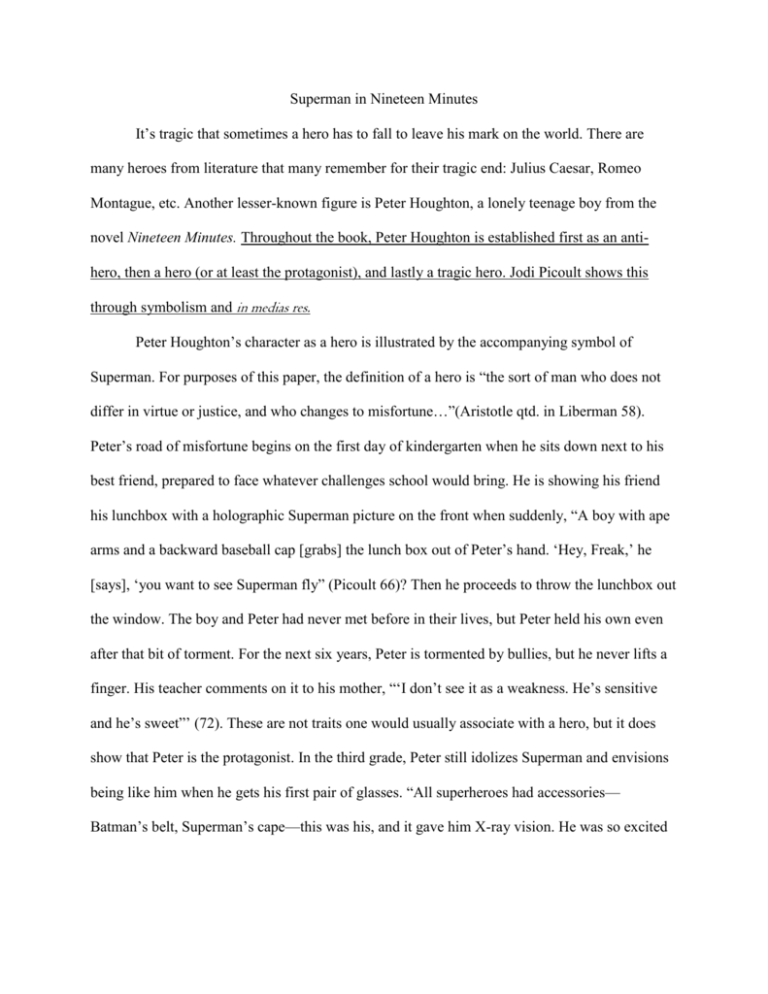
Superman in Nineteen Minutes It’s tragic that sometimes a hero has to fall to leave his mark on the world. There are many heroes from literature that many remember for their tragic end: Julius Caesar, Romeo Montague, etc. Another lesser-known figure is Peter Houghton, a lonely teenage boy from the novel Nineteen Minutes. Throughout the book, Peter Houghton is established first as an antihero, then a hero (or at least the protagonist), and lastly a tragic hero. Jodi Picoult shows this through symbolism and in medias res. Peter Houghton’s character as a hero is illustrated by the accompanying symbol of Superman. For purposes of this paper, the definition of a hero is “the sort of man who does not differ in virtue or justice, and who changes to misfortune…”(Aristotle qtd. in Liberman 58). Peter’s road of misfortune begins on the first day of kindergarten when he sits down next to his best friend, prepared to face whatever challenges school would bring. He is showing his friend his lunchbox with a holographic Superman picture on the front when suddenly, “A boy with ape arms and a backward baseball cap [grabs] the lunch box out of Peter’s hand. ‘Hey, Freak,’ he [says], ‘you want to see Superman fly” (Picoult 66)? Then he proceeds to throw the lunchbox out the window. The boy and Peter had never met before in their lives, but Peter held his own even after that bit of torment. For the next six years, Peter is tormented by bullies, but he never lifts a finger. His teacher comments on it to his mother, “‘I don’t see it as a weakness. He’s sensitive and he’s sweet”’ (72). These are not traits one would usually associate with a hero, but it does show that Peter is the protagonist. In the third grade, Peter still idolizes Superman and envisions being like him when he gets his first pair of glasses. “All superheroes had accessories— Batman’s belt, Superman’s cape—this was his, and it gave him X-ray vision. He was so excited about his new glasses that he slept with them” (76). Superhuman powers are not just something one can take off and discard when he goes to bed at night. The two times Superman is mentioned so far don’t seem so significant until they are put into context with all the other mentions of Superman. When Peter is in the sixth grade, Superman is brought up again in the form of a binder. “Today, thanks to the Superman binder, they’d started off the year with a crisis. With Josie’s help, he’d make a slipcover of sorts from the tape and an old newspaper they stole from the science lab” (139). Peter’s rejection of the Superman binder symbolizes his transformation into an anti-hero. An anti-hero is a “protagonist who lacks one or more of the conventional qualities attributed to a hero” (Kennedy, Gioia, and Bauerlein 9). Without the guidance of his idol, Peter begins to display very un-hero-like characteristics. At one point, he joins in with the bullies, tormenting someone else. “Belonging felt like helium; Peter felt himself swell inside. He’d been the one to start this; by drawing a line around Delores, he’d become part of the inner circle” (Picoult 158). The symbol of Superman was there to herald in Peter Houghton, introducing him as the protagonist and the hero; he was there as Peter rejected him in the pursuit of less-than-heroic behavior; and he was also there to consecrate Peter’s character as a tragic hero. “The experience of the tragic hero must include suffering, internal or external, as a result of the conflict necessitated by his world or universe” (Liberman and Foster 120). At the end, Peter has reached the end of his rope and, as the psychiatrist said, he was relying on his amygdala. “Peter’s capacity for planned, rational, premeditated thought is still in its developmental stages” (Picoult 404). For some time now, Peter had been contemplating suicide. After everything that had happened, , there was no more reason to live. “He fed the sock into his mouth, stuffing it as far back as it would go. When it became hard to breath, he fell into a dream. He was still eighteen, but it was the first day of kindergarten. He was carrying his backpack and his Superman lunchbox…He put his lunchbox down beside him…” (451). There it is again, just like the beginning—the Superman lunchbox, Peter’s hero who had been with him every step of the way. As Peter dies, his mind automatically goes back to his childhood hero. He had wanted to be Superman but had rejected him halfway through his life. Superman, as a symbol of the hero, shows that Peter was a hero in the beginning and a hero at his death, albeit a tragic one. Besides symbolism, it is important to note that Peter’s character is also built by the literary device of in medias res. When the novel Nineteen Minutes starts out, Peter is at his very lowest, revealing his tragic flaw at the very beginning. A tragic flaw is “a fatal weakness or ignorance in the protagonist that brings him or her to a bad end” (Kennedy, Gioga, and Bauerlein 159). On March 6, 2007, he brought a backpack full of guns to school, killed ten people, and wounded dozens of others (Picoult 424). Well, the killings were not his tragic flaw but what caused him to do it is. While Peter was being plagued by bullies on the outside, a more dangerous attack was forming inside of him. ‘“Peter was suffering from post-traumatic-stress disorder… Children who have it can’t distinguish between an immediate threat and a distant threat’” (364). And thus reveals his tragic flaw. In what he saw as self-defense, he killed ten people. The book started off with the murder to create tension within Peter’s character. It causes people to question, who is the good guy here? Then, the rest of the book is used to develop him as a hero. That little kindergartner would be viewed completely different if the knowledge of his killings was saved for later. Telling the climax first brings a depth to Peter that would not be there otherwise. During the sections that take place in the past, things are said that would not be significant without the prior knowledge, such as Peter learning how to clean his father’s rifles. “A gun was nothing, really, without a person behind it” (89). The heroic symbol of Superman and the use of in medias res are only two of the many literary devices used in Nineteen Minutes. Both of these are used to develop Peter’s character, most especially his role as hero, anti-hero, and tragic hero. It doesn’t take a dusty old story like Hamlet to create a tragic hero. You have a very good idea for your argument, and several good ideas you raise throughout. I like how you took a less-familiar hero, and I love the idea of the Superman symbol. You also did a great job organizing your argument in your thesis (the different kinds of heroes). The major problem you face is use of evidence. The paper seems more of a summary, but you have claims and quotes; it’s really a matter of removing summary and inserting analysis. Once you do that, we’ll both see a major improvement in your paper. I’m sure you can do it, too. Other concerns are the length of the paper (should be a full four pages) and tone (sometimes the wording is too casual. See comment A17). Also be careful—you outlined a very specific paper in your thesis, but you didn’t stick to it through the topic sentences (you didn’t focus on the different kinds of hero roles the main character filled, but you mention them explicitly in your thesis). You’ve got some work ahead of you, but I have full faith you can do it. You showed evidence of that ability in your paper. Works Cited Kennedy, X. J., Dana Gioia, and Mark Bauerlein. Handbook of Literary Terms Literature, Language, Theory (2nd Edition). New York: Longman, 2008. Print. Liberman, M.M., and Edward E. Foster. A Modern Lexicon of Literary Terms. United States: Scott, Foresman and Company, 1968. Print. Picoult, Jodi. Nineteen Minutes. New York: Atria Books, 2007. Print.
